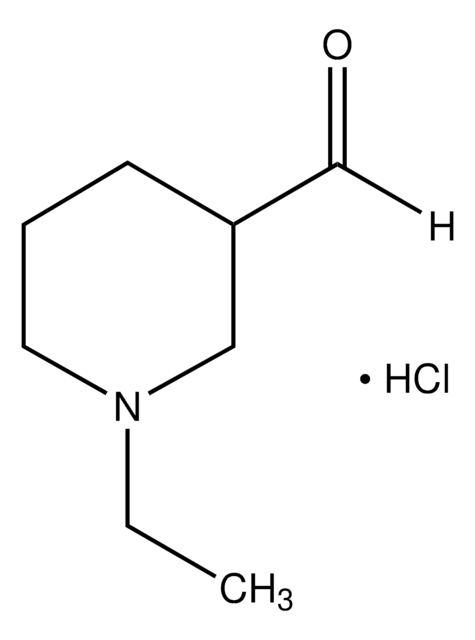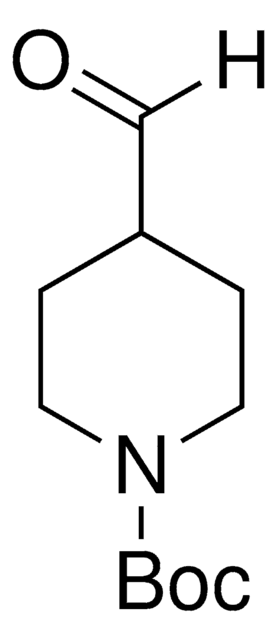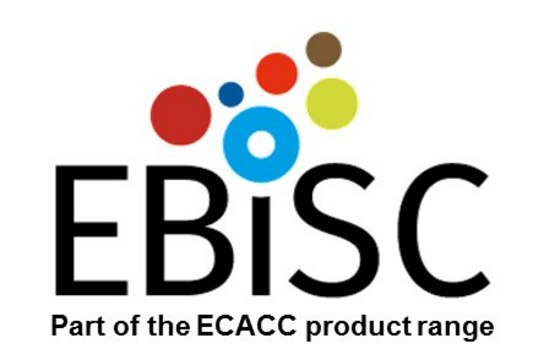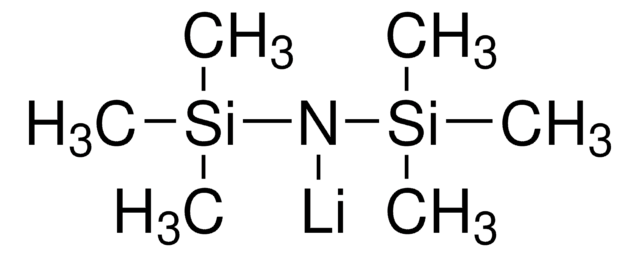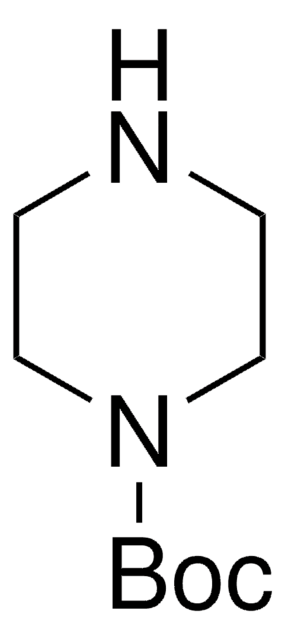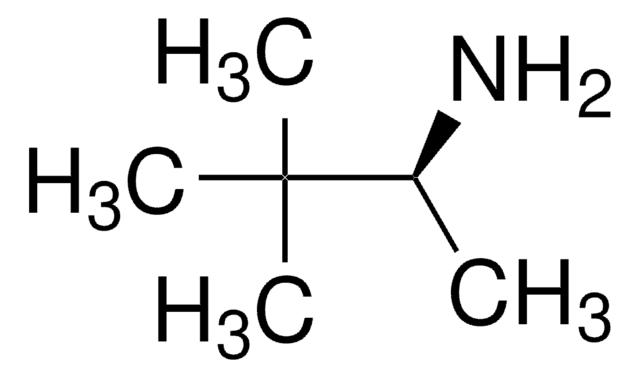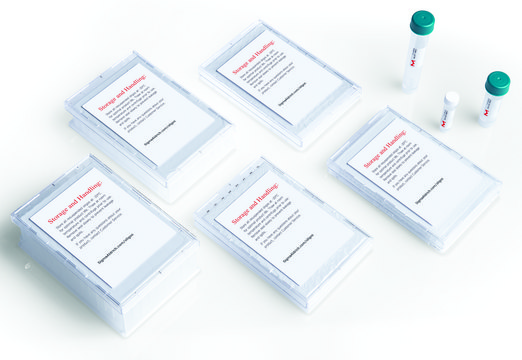推荐产品
一般描述
iPS cell line derived with OSKM retrovirus. Lines have been evaluated for exogenounes gene silencing and concomitant expression of corresponding endogenous genes.
应用
Cell plating density is ~20,000 cells/cm2
Media renewal changes daily
Rapidly thaw vial by gentle agitation in 37°C water bath (~2 minutes), keeping vial cap out of the water. Decontaminate with 70% ethanol, add 9 mL culture media and centrifuge 200 x g (5 minutes). Resuspend in complete culture media and incubate at 37°C in a 5% CO2 atmosphere.
The recommended culture media is Stemline Pluripotent Media, Cat. No. S1202, with Extra Cellular Matrix, Cat. No. E1270.
特点和优势
ZFN mediated KI of RFP into endogenous loci of ACTB
iPS cell line has been shown to express normal pluripotency markers (i.e. Tra1-60, Oct3/4, nanog) via ICC and/or PCR methods. Cell line has also been shown to retain the capacity to differentiate into all three germ layers via spontaneous embryoid body differentiation and has been shown to be karyotypically normal.
iPSC b-ACTIN RFP cells are produced by OSKM retrovirus reprogramming of epithelial cells from a Caucasian female 24 years of age with no known genetic disorders. iPSC b-ACTIN RFP cells have ACTB regulated expression of RFP. Six different isoforms of actin are known in humans. b-Actin is one of two non-muscle cytoskeletal actins involved in cell motility, structure, and integrity.
iPS cell line has been shown to express normal pluripotency markers (i.e. Tra1-60, Oct3/4, nanog) via ICC and/or PCR methods. Cell line has also been shown to retain the capacity to differentiate into all three germ layers via spontaneous embryoid body differentiation and has been shown to be karyotypically normal.
iPSC b-ACTIN RFP cells are produced by OSKM retrovirus reprogramming of epithelial cells from a Caucasian female 24 years of age with no known genetic disorders. iPSC b-ACTIN RFP cells have ACTB regulated expression of RFP. Six different isoforms of actin are known in humans. b-Actin is one of two non-muscle cytoskeletal actins involved in cell motility, structure, and integrity.
iPS cell line has been shown to express normal pluripotency markers (i.e. Tra1-60, Oct3/4, nanog) via ICC and/or PCR methods. Cell line has also been shown to retain the capacity to differentiate into all three germ layers via spontaneous embryoid body differentiation and has been shown to be karyotypically normal.
质量
Tested for Mycoplasma, sterility, post-freeze viability, short terminal repeat (STR) analysis for cell line identification, cytochrome oxidase I (COI) analysis for cell line species confirmation
法律信息
Kyoto Label license:
1. SA Licensed Pluripotent Products- [Licensed iPS Cells and Licensed iPS Cell Kit Products (components used to produce iPS Cells)]
(i) End User shall not use SA Pluripotent Products and its derivatives for uses other than for End User′s internal research use; End User may not use the SA Pluripotent Products and its derivatives for Commercial Purpose*.
(ii) If End User wishes to use SA Pluripotent Products and its derivatives for Commercial Purpose, End User shall contact AJ to negotiate a requisite license.
(iii) End User shall not transfer, sell or supply any SA Pluripotent Products and its derivatives to Third Parties, except that End User may transfer SA Pluripotent Products and its derivatives solely to bona-fide collaborators and/or sub-contractors who perform research activities excluding Commercial Purpose*solely for End User′s research (but not for End User′s financial gain) on behalf of and under the direct control of the End-User.
(iv) End User shall not use SA Pluripotent Products and its derivatives for administration and use for humans/animal therapeutic, diagnostic and/or prophylactic purposes including but not limited to clinical applications, cell therapy, transplantation, and/or regenerative medicine.
(v) No other right, express or implied is conveyed by the sale of SA Pluripotent Products.
*Commercial Purpose includes use of the SA Pluripotent Products and its derivatives, (i) for the manufacture of related products (i.e., culture medium and equipment) distributed or sold to a Third Party; (ii) to provide a service, information or data to a Third Party; and (iii) for screening commercially active compounds for the purpose of developing the compound for commercial sale.
2. Licensed Differentiated Cells
(i) End User shall not use Licensed Differentiated Cells for uses other than for End User′s internal research use. For clarity, End User is allowed to use Licensed Differentiated Cells for research use in screening applications, including high-throughput screens inclusive of small molecules, antibodies, proteins, peptides, miRNAs, and large molecule screening.
(ii) End User may transfer, distribute or supply Licensed Differentiated Cells to Third Parties in accordance with section 2(iii) of the Customer Notice.
(iii) End User shall not use Licensed Differentiated Cells for administration and use for humans/animal therapeutic, diagnostic and/or prophylactic purposes including but not limited to clinical applications, cell therapy, transplantation, and/or regenerative medicine.
(iv) No other right, express or implied is conveyed by the sale of Licensed Differentiated Cells.
1. SA Licensed Pluripotent Products- [Licensed iPS Cells and Licensed iPS Cell Kit Products (components used to produce iPS Cells)]
(i) End User shall not use SA Pluripotent Products and its derivatives for uses other than for End User′s internal research use; End User may not use the SA Pluripotent Products and its derivatives for Commercial Purpose*.
(ii) If End User wishes to use SA Pluripotent Products and its derivatives for Commercial Purpose, End User shall contact AJ to negotiate a requisite license.
(iii) End User shall not transfer, sell or supply any SA Pluripotent Products and its derivatives to Third Parties, except that End User may transfer SA Pluripotent Products and its derivatives solely to bona-fide collaborators and/or sub-contractors who perform research activities excluding Commercial Purpose*solely for End User′s research (but not for End User′s financial gain) on behalf of and under the direct control of the End-User.
(iv) End User shall not use SA Pluripotent Products and its derivatives for administration and use for humans/animal therapeutic, diagnostic and/or prophylactic purposes including but not limited to clinical applications, cell therapy, transplantation, and/or regenerative medicine.
(v) No other right, express or implied is conveyed by the sale of SA Pluripotent Products.
*Commercial Purpose includes use of the SA Pluripotent Products and its derivatives, (i) for the manufacture of related products (i.e., culture medium and equipment) distributed or sold to a Third Party; (ii) to provide a service, information or data to a Third Party; and (iii) for screening commercially active compounds for the purpose of developing the compound for commercial sale.
2. Licensed Differentiated Cells
(i) End User shall not use Licensed Differentiated Cells for uses other than for End User′s internal research use. For clarity, End User is allowed to use Licensed Differentiated Cells for research use in screening applications, including high-throughput screens inclusive of small molecules, antibodies, proteins, peptides, miRNAs, and large molecule screening.
(ii) End User may transfer, distribute or supply Licensed Differentiated Cells to Third Parties in accordance with section 2(iii) of the Customer Notice.
(iii) End User shall not use Licensed Differentiated Cells for administration and use for humans/animal therapeutic, diagnostic and/or prophylactic purposes including but not limited to clinical applications, cell therapy, transplantation, and/or regenerative medicine.
(iv) No other right, express or implied is conveyed by the sale of Licensed Differentiated Cells.
WGK
WGK 3
闪点(°F)
Not applicable
闪点(°C)
Not applicable
法规信息
新产品
商品
The Simplicon™ RNA Reprogramming Technology is a next generation reprogramming system that uses a single synthetic, polycistronic self-replicating RNA strand engineered to mimic cellular RNA to generate human iPS cells.
我们的科学家团队拥有各种研究领域经验,包括生命科学、材料科学、化学合成、色谱、分析及许多其他领域.
联系技术服务部门